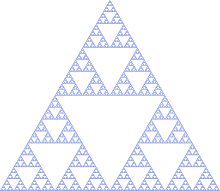Null set

Inmathematical analysis,anull setis aLebesgue measurable setof real numbers that hasmeasurezero.This can be characterized as a set that can becoveredby acountableunion ofintervalsof arbitrarily small total length.
The notion of null set should not be confused with theempty setas defined inset theory.Although the empty set hasLebesgue measurezero, there are also non-empty sets which are null. For example, any non-empty countable set of real numbers has Lebesgue measure zero and therefore is null.
More generally, on a givenmeasure spacea null set is a setsuch that
Examples[edit]
Every finite or countably infinite subset of the real numbers is a null set. For example, the set of natural numbers and the set of rational numbers are both countably infinite and therefore are null sets when considered as subsets of the real numbers.
TheCantor setis an example of an uncountable null set.[further explanation needed]
Definition[edit]
Supposeis a subset of thereal linesuch that for everythere exists a sequenceof openintervals(where intervalhas lengthsuch that thenis a null set,[1]also known as a set of zero-content.
In terminology ofmathematical analysis,this definition requires that there be asequenceofopen coversoffor which thelimitof the lengths of the covers is zero.
Properties[edit]
Letbe ameasure space.We have:
- (bydefinitionof).
- Anycountableunionof null sets is itself a null set (bycountable subadditivityof).
- Any (measurable) subset of a null set is itself a null set (bymonotonicityof).
Together, these facts show that the null sets ofform a𝜎-idealof the𝜎-algebra.Accordingly, null sets may be interpreted asnegligible sets,yielding a measure-theoretic notion of "almost everywhere".
Lebesgue measure[edit]
TheLebesgue measureis the standard way of assigning alength,areaorvolumeto subsets ofEuclidean space.
A subsetofhas null Lebesgue measure and is considered to be a null set inif and only if:
- Given anypositive numberthere isasequenceofintervalsinsuch thatis contained in the union of theand the total length of the union is less than
This condition can be generalised tousing-cubesinstead of intervals. In fact, the idea can be made to make sense on anymanifold,even if there is no Lebesgue measure there.
For instance:
- With respect toallsingleton setsare null, and therefore allcountable setsare null. In particular, the setofrational numbersis a null set, despite beingdensein
- The standard construction of theCantor setis an example of a nulluncountable setinhowever other constructions are possible which assign the Cantor set any measure whatsoever.
- All the subsets ofwhosedimensionis smaller thanhave null Lebesgue measure inFor instance straight lines or circles are null sets in
- Sard's lemma:the set ofcritical valuesof a smooth function has measure zero.
Ifis Lebesgue measure forand π is Lebesgue measure for,then theproduct measureIn terms of null sets, the following equivalence has been styled aFubini's theorem:[2]
- Forand
Uses[edit]
Null sets play a key role in the definition of theLebesgue integral:if functionsandare equal except on a null set, thenis integrable if and only ifis, and their integrals are equal. This motivates the formal definition ofspacesas sets of equivalence classes of functions which differ only on null sets.
A measure in which all subsets of null sets are measurable iscomplete.Any non-complete measure can be completed to form a complete measure by asserting that subsets of null sets have measure zero. Lebesgue measure is an example of a complete measure; in some constructions, it is defined as the completion of a non-completeBorel measure.
A subset of the Cantor set which is not Borel measurable[edit]
The Borel measure is not complete. One simple construction is to start with the standardCantor setwhich is closed hence Borel measurable, and which has measure zero, and to find a subsetofwhich is not Borel measurable. (Since the Lebesgue measure is complete, thisis of course Lebesgue measurable.)
First, we have to know that every set of positive measure contains a nonmeasurable subset. Letbe theCantor function,a continuous function which is locally constant onand monotonically increasing onwithandObviously,is countable, since it contains one point per component ofHencehas measure zero, sohas measure one. We need a strictlymonotonic function,so considerSinceis strictly monotonic and continuous, it is ahomeomorphism.Furthermore,has measure one. Letbe non-measurable, and letBecauseis injective, we have thatand sois a null set. However, if it were Borel measurable, thenwould also be Borel measurable (here we use the fact that thepreimageof a Borel set by a continuous function is measurable;is the preimage ofthrough the continuous function) Therefore,is a null, but non-Borel measurable set.
Haar null[edit]
In aseparableBanach spacethe group operation moves any subsetto the translatesfor anyWhen there is aprobability measureμon the σ-algebra ofBorel subsetsofsuch that for allthenis aHaar null set.[3]
The term refers to the null invariance of the measures of translates, associating it with the complete invariance found withHaar measure.
Some algebraic properties oftopological groupshave been related to the size of subsets and Haar null sets.[4] Haar null sets have been used inPolish groupsto show that whenAis not ameagre setthencontains an open neighborhood of theidentity element.[5]This property is named forHugo Steinhaussince it is the conclusion of theSteinhaus theorem.
See also[edit]
- Cantor function– Continuous function that is not absolutely continuous
- Empty set– Mathematical set containing no elements
- Measure (mathematics)– Generalization of mass, length, area and volume
- Nothing– Complete absence of anything; the opposite of everything
References[edit]
- ^Franks, John (2009).A (Terse) Introduction to Lebesgue Integration.The Student Mathematical Library. Vol. 48.American Mathematical Society.p. 28.doi:10.1090/stml/048.ISBN978-0-8218-4862-3.
- ^van Douwen, Eric K. (1989). "Fubini's theorem for null sets".American Mathematical Monthly.96(8): 718–21.doi:10.1080/00029890.1989.11972270.JSTOR2324722.MR1019152.
- ^Matouskova, Eva (1997)."Convexity and Haar Null Sets"(PDF).Proceedings of the American Mathematical Society.125(6): 1793–1799.doi:10.1090/S0002-9939-97-03776-3.JSTOR2162223.
- ^Solecki, S. (2005). "Sizes of subsets of groups and Haar null sets".Geometric and Functional Analysis.15:246–73.CiteSeerX10.1.1.133.7074.doi:10.1007/s00039-005-0505-z.MR2140632.S2CID11511821.
- ^Dodos, Pandelis (2009). "The Steinhaus property and Haar-null sets".Bulletin of the London Mathematical Society.41(2): 377–44.arXiv:1006.2675.Bibcode:2010arXiv1006.2675D.doi:10.1112/blms/bdp014.MR4296513.S2CID119174196.
Further reading[edit]
- Capinski, Marek; Kopp, Ekkehard (2005).Measure, Integral and Probability.Springer. p. 16.ISBN978-1-85233-781-0.
- Jones, Frank (1993).Lebesgue Integration on Euclidean Spaces.Jones & Bartlett. p. 107.ISBN978-0-86720-203-8.
- Oxtoby, John C. (1971).Measure and Category.Springer-Verlag. p. 3.ISBN978-0-387-05349-3.








































![{\displaystyle [0,1],}](https://wikimedia.org/api/rest_v1/media/math/render/svg/971caee396752d8bf56711f55d2c3b1207d4a236)





















